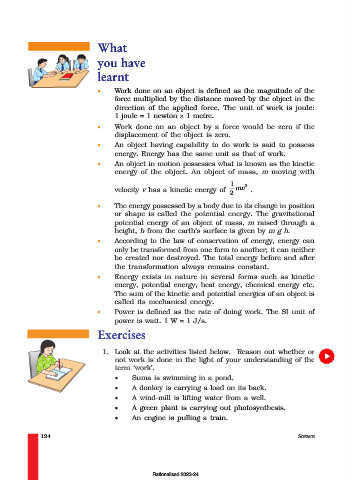Page 135 - Understanding NCERT Science 09
P. 135
What
you have
learnt
• Work done on an object is defined as the magnitude of the
force multiplied by the distance moved by the object in the
direction of the applied force. The unit of work is joule:
1 joule = 1 newton × 1 metre.
• Work done on an object by a force would be zero if the
displacement of the object is zero.
• An object having capability to do work is said to possess
energy. Energy has the same unit as that of work.
• An object in motion possesses what is known as the kinetic
energy of the object. An object of mass, m moving with
1 2
velocity v has a kinetic energy of mv .
2
• The energy possessed by a body due to its change in position
or shape is called the potential energy. The gravitational
potential energy of an object of mass, m raised through a
height, h from the earth’s surface is given by m g h.
• According to the law of conservation of energy, energy can
only be transformed from one form to another; it can neither
be created nor destroyed. The total energy before and after
the transformation always remains constant.
• Energy exists in nature in several forms such as kinetic
energy, potential energy, heat energy, chemical energy etc.
The sum of the kinetic and potential energies of an object is
called its mechanical energy.
• Power is defined as the rate of doing work. The SI unit of
power is watt. 1 W = 1 J/s.
Exercises
1. Look at the activities listed below. Reason out whether or
not work is done in the light of your understanding of the
term ‘work’.
• Suma is swimming in a pond.
• A donkey is carrying a load on its back.
• A wind-mill is lifting water from a well.
• A green plant is carrying out photosynthesis.
• An engine is pulling a train.
124 SCIENCE
Rationalised 2023-24

